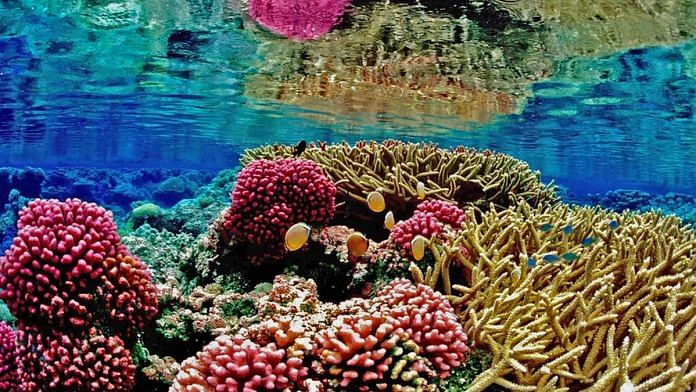Bengaluru: A recently-published 14-year study has found that there are strong indicators that corals in Lakshadweep have undergone bleaching in the last few decades.
The study, titled ‘Impact of sea surface temperature anomalies on giant clam population dynamics in Lakshadweep reefs’, was published last month by researchers at the Bombay Natural History Society (BNHS) and Wildlife Institute of India (WII) in the journal Ecological Indicators.
For the study, the researchers have analysed three coral reefs — Agatti, Bangaram-Tinakkara and Kavaratti — outside the lagoons in the Lakshadweep archipelago between 2004 and 2017.
‘Bleaching’ is the term given to the process during which corals, under stress from warm weather, expel the algae that live in their tissues and produce their food. These are the same algae that give colour to corals.
The researchers studied the impacts of sea-surface temperature anomalies on populations of tridacna maxima, a species of giant clams in the Lakshadweep that have a higher threshold to increasing temperatures than corals. In essence, the species tridacna maxima were used as a surrogate to study the impact of temperature rise on corals.
“The study period included two bleaching events and we found that the bivalves (tridacna maxima) had bleached, so the corals must definitely have bleached,” said Deepak Apte, director at BNHS, adding that in Lakshadweep, corals bleach when temperatures touch 29°C or 30°C whereas in the Kutch, “they can sustain up to 40 degrees (celsius) because, over the years, they have naturally been exposed to higher temperatures”.
This is the reasoning behind a proposal being submitted to the Ministry of Environment, Forests and Climate Change to translocate corals from reefs considered as relatively more temperature-tolerant in Gujarat’s Kutch region to the ones in Lakshadweep.
The proposal is the first-of-its-kind considering that it involves translocation purely for building temperature resilience — from one healthy reef to another — whereas earlier, corals were translocated from healthy reefs to degraded ones.
Also read: Dead coral reefs could be revived by playing sounds of healthy reefs, finds study
Coral bleaching impacts marine habitat
A coral reef ecosystem consists of a variety of plants and animals like fish, molluscs, algae, crustaceans like crabs, lobsters, shrimps and prawns, with corals being the dominant animal species, (yes, corals are animals).
The survival of this ecosystem depends on the intricate relationship that all these organisms share. Given this form of coexistence, coral bleaching is a serious phenomenon because it impacts the habitat function that reefs provide to a diverse group of marine species, which use the niches as settlements to live and reproduce, and as shelter to escape from predators.
Coral reefs also act as ‘wave breaks’ between the sea and the coastline and minimise the impacts of sea erosion.
And while corals can recover from mild bleaching incidents brought about by bouts of high temperatures, the damage can be irreversible in cases where temperatures constantly remain high. It should also be noted that even recovery processes can take several decades and so, temperatures will have to be within the range that is considered ‘normal’ for long periods of time to enable recovery.
Tropical reefs are now transitioning to a new era
The first-ever global-level bleaching incident was observed in 1982–83. After this, several cases of elevated sea surface temperatures and associated bleaching incidents have occurred worldwide.
During the period of the study, bleaching events were observed twice — one in 2010 and another in 2016. The researchers observed that after a period of stable increase between 2004 and 2010, the density of tridacna maxima in the three reefs sharply declined immediately after the bleaching incident in 2010. This was followed by a period of stable decline until the next bleaching event in 2016 when further decline was documented.
“Climate change-induced elevated SST (sea surface temperature) is likely to compromise the population viability of giant clams,” the researchers wrote in the paper, indicating that the chances of survival for corals, too, would stand compromised under warmer temperatures.
Coral reefs are also increasingly being considered as bio-indicators for climate change because they are sensitive to rise in temperature and an increase in the sea level.
In the paper, the researchers noted that tropical reefs are now “transitioning to a new era wherein, the interval between recurrent bouts of coral bleaching is “too short for the full recovery of mature assemblages”.
‘Assemblage’ refers to the coral assemblage, which is the symbiotic relationship that plants and animals in a coral reef share. The researchers noted that with every hot summer comes a potential for coral bleaching and mortality and that corals, which usually take at least 10-15 years to recover from heat stress, are now unable to cope with “recurrent stresses”.
Apte said their team is currently proposing a thorough, three-year, risk-assessment study to ascertain the potential risks — like the transfer of pathogens — involved in translocating corals from Kutch to Lakshadweep.
If the risks involved are minimal, “we could ensure that reefs in Lakshadweep do not undergo bleaching very easily,” he said, adding that otherwise, the chances of corals surviving in the reefs around Lakshadweep “are very slim if temperatures continue to rise the way it is rising now”.
Coral translocation has been done on many occasions in India, including most recently in Lakshadweep, Tamil Nadu and Gujarat.
Considering that the current proposal is unique, Apte noted that three years will be dedicated to assessing the risks by studying corals of both Kutch and Lakshadweep to analyse the algae that are living in them and the potential risk in the pathogen transfer after translocation.
Rishika Pardikar is a freelance journalist based in Bengaluru.
(Edited by Debalina Dey)
Also read: Surviving climate change, these super corals can handle acid, heat and suffocation



